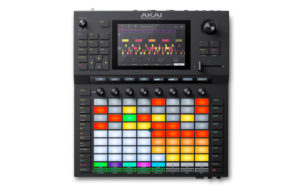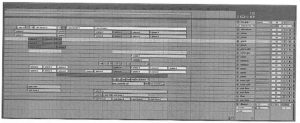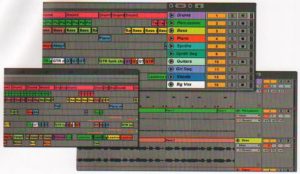Wow! Winter NAMM 2019 is one week away and we’ve seen major new products everywhere.
The Akai Pro Force is a much-anticipated product — a standalone, Ableton Live-like workstation. Force is a clip-oriented production workstation with real-time pitch and time stretch. Force will include FX plug-ins from AIR Music Technology. Synth engines include TubeSynth, Bassline, Electric, and Hype. [Click image to enlarge.]
Here’s a dump of the features courtesy of Akai:
- Standalone – no computer needed
- Matrix of 8×8 RGB pads for triggering clips
- 7-inch multi-touch screen
- 1 push encoder wheel for navigation and selection
- 1 crossfader A / B
- 2 combo inputs Xlr / Mic Jack / instruments / line
- 4 TRS outputs
- MIDI In / Out / Thru minijack (minijack to 5-pin adapters included)
- 4 configurable CV / Gate outputs
- Remix, merge and produce with 6 different programs for complete audio / MIDI / CV sequencing
- Performance modes including drum MPC, notes, smart note suite, chords and chord progression
- MPC Sample Editor
- Automatic detection of BPM, real-time time stretching and pitch modulation
- 8 Q-Link touch-sensitive potentiometers with individual graphic OLED display
- 4 powerful and fully customizable synthesis engines
- 16 GB of internal memory (including more than 10 GB of sounds included)
- SD card slot and 2 USB 3.0 ports compatible with USB storage devices or MIDI controllers
- 2.5 “SATA connector internally (SSD or HDD) for an extension of the internal storage by the user
- 1 Type-B USB port for connecting to a Mac / PC computer
- 1 TRS headphone output
- Weight and dimensions: 3.87 kg, 350 x 389 x 72.5 mm
Expected USA street price is $1,499 USD. The integrated display is a 7-inch, back-lit color touch screen.
Of course, the specs do not convey what it’s like to actually use the Force. [Oh, dear. This is already so cliched, I’m embarrassed.] Akai have deep experience with controller workflow, so the Force shouldn’t disappoint.
Akai intend to deliver Ableton Live controller capabilities in March 2019.
Copyright © 2019 Paul J. Drongowski



